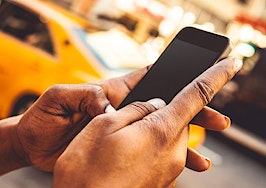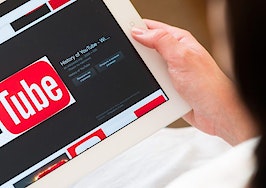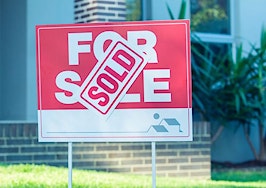- Apps and websites that use IDX and syndicated listing data are too slow to post listings in a hot market.
- Homebuyers will often see a yard sign in front of a new home listed for sale before the listing is added to the local MLS database.
- Integrated curbside marketing weds the yard sign with advanced text and phone capabilities, which helps agents identify these prospects and provide them with seamlessly automated information from the curb through text and audio.
In most markets today, well-priced homes are commonly getting multiple offers within the first few days of being on the market. What has gone largely unnoticed is how the yard sign, a core component of curbside marketing, is helping agents because IDX — and syndicated listing data — is too slow in a hot market.
Historically, yard signs have been atop of an agent’s list of the most effective marketing tools. The most recent National Association of Realtors’ research tells that the yard sign remains the third most powerful way buyers found a home to purchase, and it’s been that way for 14 years straight. Only the internet and real estate professionals top yard signs as the best way to find a home.
Yard signs have evolved with technology to be an intrinsic part of what’s known as integrated curbside marketing. Integrated curbside marketing weds the yard sign with advanced text and phone capabilities that enable an agent to identify calls from prospective buyers who are standing in front of or driving by a yard sign.
Today’s curbside marketing helps agents identify these prospects and provide them with seamlessly automated information from the curb through text and audio. This done properly engages the buyer and agent as the agent provides immediate and meaningful value to the buyer.
Let’s, look at why curbside marketing has a major advantage over online tools that need IDX to update — or worse, syndicated data to update.
Pre-marketing advantage
Homebuyers will often see a yard sign in front of a new home listed for sale before the listing is added to the local MLS database. Smart, ready-to-buy home shoppers typically already know where they want to live and have discovered that if they rely on seeing new listings on an app, they’ve often waited too long.
Therefore, they often drive the area on a regular basis. That’s what happens in a hot seller’s market when inventory is low, demand is high and the days on market collapse.
If a buyer relies on an app, it’s not going help them when the listing isn’t going to appear on their app until 24 hours or more after the yard sign is up and the listing is under contract.
Contextual advantage
Smart homebuyers also have discovered that beautiful pictures can’t hide the stark reality of a house when they are standing in front of it. That’s a huge contextual advantage that buyers who drive around looking for new yard signs discover.
Photos can obfuscate layout, room sizes and physical blemishes that are more easily discerned by physically visiting the home.
Privacy concerns
Many people are unwilling to download and create a user account in an app or a website and identify themselves as they are not ready to commit to working with that particular agent or brokerage.
Mobile sites can greatly increase buyer engagement as they can skip this step. Buyers know that stopping in front of a yard sign to view a house can be done anonymously: They decide when they are willing to disclose their information to see that particular home.
Speed advantage
The one thing that homebuyers universally know about most markets is that they need to be fast. Moving fast means they need to be on the hunt for homes that are being pre-marketed at the curb, not online.
In a tight market, finding the yard sign that just went up is how a buyer is going to be able to get an advantage over other buyers.
Even though brokers are getting refreshed IDX feeds in real-time, agents will have signs put up often days before the new listing appears on online sites or in apps.
The opportunity for agents with this approach: they can generate more leads, and some have the chance to get both sides of the transaction in this pre-marketing phase. In a tight market, this is just about the only way an agent is going to capture both sides of the transaction for themselves or their brokerage — because remember that a yard sign is non-display.
Technology loses in this particular environment as it is being held back by the rules that govern real estate listing data. Curbside marketing trumps app and website technology in a hot market because the “IDX display rules” prevent a listing from being marketed until it is active in the MLS — but those rules (obviously) don’t apply to yard sign.
Savvy, aggressive homebuyers know when they see a new yard sign to contact the listing agent directly, as it might be faster that way.
It’s during this pre-marketing stage that listing agents seize the opportunity to use that yard sign to drive new potential buyer leads their way.
With curbside marketing, the phone number on the sign can direct potential buyers to the agent (or an audio recording about the property) — because no MLS data is required to answer a call or text.
What technology can do
When potential homebuyers call or text from the curb, agents need to respond quickly. Voice mail should not be an option. We know from our own exhaustive research that 42 percent of all calls go to voicemail, and most drive-bys don’t leave messages.
This is where integrated curbside marketing technology works best. Today, smart calling technology allows an agent to be in many places at once, utilizing simultaneous ringing — where their office phone, their cell phone and their associate or assistant’s phone all ring at the same time — to avoid sending that homebuyer calling from the yard sign to voicemail.
The reason so many calls go to voicemail is that the agent can’t distinguish between a call from a prospective buyer and a time-suck call from a number they don’t recognize.
To solve this problem, phone technology now offers a feature known as visual lead notification. When a prospective buyer calls from the phone number displayed on the yard sign, their call is routed to the agent or their representative.
Instead of agents seeing a phone number they don’t recognize, it will display “buyer” on their caller ID, so the agent knows to answer their phone immediately.
Curbside marketing technology takes advantage of that data-lag that apps face while making sure that agents know when real prospects are calling so they save the caller from voicemail while increasing their business — even in a tight market like today.
Randall Standard is CEO of VoicePad and a 20-plus year veteran of the mobile phone industry.












